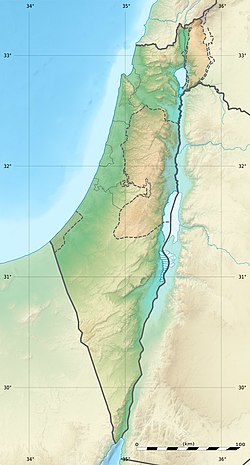
Back عسقلان القديمة Arabic Askalon (antiikin kaupunki) Finnish אשקלון (עיר עתיקה) HE اشکلون Urdu 阿斯卡隆 Chinese
𐤀𐤔𐤒𐤋𐤍 אַשְׁקְלוֹן Ἀσκάλων عَسْقَلَان | |
 Remains of the Church of Santa Maria Viridis | |
| Location | Southern District, Israel |
|---|---|
| Region | Southern Levant, Middle East |
| Coordinates | 31°39′43″N 34°32′46″E / 31.66194°N 34.54611°E |
| Type | Settlement |
| History | |
| Founded | c. 2000 BC |
| Abandoned | 1270 AD |
| Periods | Bronze Age to Crusades |
| Cultures | Philistine(?), Crusaders |
| Site notes | |
| Excavation dates | 1815, 1920-1922, 1985-2016 |
| Archaeologists | Lady Hester Stanhope, John Garstang, W. J. Phythian-Adams, Lawrence Stager, Daniel Master |
Ascalon (Philistine: 𐤀𐤔𐤒𐤋𐤍, romanized: *ʾAšqalōn;[1] Hebrew: אַשְׁקְלוֹן, romanized: ʾAšqəlōn; Koinē Greek: Ἀσκάλων, romanized: Askálōn; Latin: Ascalon; Arabic: عَسْقَلَان, romanized: ʿAsqalān) was an ancient Near East port city on the Mediterranean coast of the southern Levant that played a major role in several historical periods. Its importance diminished after the Mamluks destroyed its strategically significant fortifications and port in the 13th century.[2]
Ashkelon reveals traces of settlement from the 3rd millennium BC, with evidence suggesting the emergence of a major fortified city during the Middle Bronze Age. Early references to Ashkelon appear in Egyptian "execration texts." Subsequently, during the Late Bronze Age, Ashkelon was integrated into the Egyptian Empire and is mentioned in various texts, including the Amarna letters. Following the migration of the Sea Peoples, Ashkelon became one of the five cities of the Philistine pentapolis, alongside Ashdod, Ekron, Gath, and Gaza. The city was later destroyed by the Babylonians but was subsequently rebuilt.[2]
Ascalon remained a major metropolis throughout antiquity and the early Middle Ages, before becoming a highly contested fortified foothold on the coast during the Crusades, when it became the site of two significant Crusader battles: the Battle of Ascalon in 1099, and the Siege of Ascalon in 1153. The Mamluk sultan Baybars ordered the destruction (slighting) of the city fortifications and the harbour in 1270 to prevent any further military use, though structures such as the Shrine of Husayn's Head survived. The nearby town of al-Majdal was established in the same period.
Ottoman tax records attest the existence of the village of Al-Jura adjacent to citadel walls from at least 1596.[3] That residual settlement survived until its depopulation in 1948. The modern Israeli city of Ashkelon takes its name from the ancient city.
- ^ Huehnergard, John (2018). "The Name Ashkelon". Eretz-Israel: Archaeological, Historical and Geographical Studies. 33: 91–97. JSTOR 26751887.
- ^ a b Lemche, Niels Peter (2004). Historical dictionary of ancient Israel. Historical dictionaries of ancient civilizations and historical eras. Lanham, Md.: Scarecrow Press. p. 63. ISBN 978-0-8108-4848-1.
ASHKELON. A major city and important harbor on the southern coast of Palestine about 50 kilometers south of modern Tel Aviv. It was excavated in 1920, and again in ongoing excavations since 1985. /.../ Although destroyed by the Babylonians in 604 B.C.E., it was soon rebuilt and remained an important center of trade not only in Persian times but actually until the Middle Ages when it was finally destroyed by Arab rulers after their victories over the crusaders.
- ^ Hütteroth and Abdulfattah, 1977, p. 150. Quoted in Khalidi, 1992, p. 116
© MMXXIII Rich X Search. We shall prevail. All rights reserved. Rich X Search
